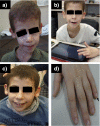Identification of a de novo splicing variant in the Coffin-Siris gene, SMARCE1, in a patient with Angelman-like syndrome
- PMID: 30548424
- PMCID: PMC6382443
- DOI: 10.1002/mgg3.511
Identification of a de novo splicing variant in the Coffin-Siris gene, SMARCE1, in a patient with Angelman-like syndrome
Abstract
Background: Patients affected by Angelman syndrome (AS) present severe intellectual disability, lack of speech, ataxia, seizures, abnormal electroencephalography (EEG), and a characteristic behavioral phenotype. Around 10% of patients with a clinical diagnosis of AS (AS-like) do not have an identifiable molecular defect. Some of these patients harbor alternative genetic defects that present overlapping features with AS.
Methods: Trio whole-exome sequence was performed on patient and parent's DNA extracted from peripheral blood. Exome data were filtered according to a de novo autosomal dominant inheritance. cDNA analysis was carried out to assess the effect of the splice site variant.
Results: We identified a novel heterozygous SMARCE1 splicing variant that leads to an exon skipping in a patient with an Angelman-like phenotype. Missense variants in the SMARCE1 gene are known to cause Coffin-Siris syndrome (CSS), which is a rare congenital syndrome. Clinical reevaluation of the patient confirmed the presence of characteristic clinical features of CSS, many of them overlapping with AS.
Conclusions: Taking into account the novel finding reported in this study, we consider that CSS should be added to the expanding list of differential diagnoses for AS.
Keywords: SMARCE1; Angelman syndrome (AS); Coffin-Siris syndrome (CSS); exome sequencing.
© 2018 The Authors. Molecular Genetics & Genomic Medicine published by Wiley Periodicals, Inc.
Figures


References
Publication types
MeSH terms
Substances
LinkOut - more resources
Full Text Sources
Research Materials

